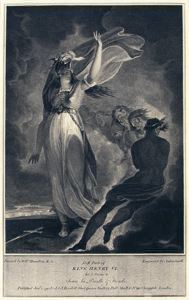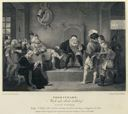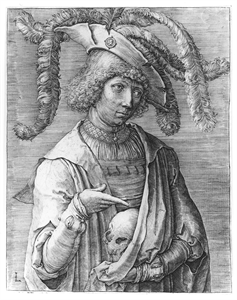
John Boydell
English, 1719–1804
Josiah Boydell (aka Joshua Boydell)
English, 1752–1817
Anker Smith
English, 1759–1819
after William Hamilton
English, 1751–1801
From Boydell's Graphic Illustrations of the Dramatic Works of Shakespeare
In 1786, a successful London publisher, alderman John Boydell, conceived of a gallery of art devoted to scenes from Shakespeare’s plays. Named for its founder, the Boydell Shakespeare Gallery was one of the first large-scale commercial endeavors intended to promote British literature and artists both in Great Britain as well as throughout the European continent. He commissioned over 167 paintings of scenes from Shakespeare’s plays and produced engravings based on these paintings. In creating the engravings, John Boydell partnered with his son, Josiah, whose name appears after his father’s in the list above. The third name is that of the engraver, and the fourth is that of the painter who created the original composition in oils. The role of the engraver was to transfer the painter’s composition onto plates for printing.
About this scene:
Shakespeare developed the modern history play with his Wars of the Roses tetralogy (1591–93), and all four plays feature troublesome females—and males. InHenry VI , England is now losing its war with France due to ambitious English rivalries and the French, re-inspired by Joan of Arc. The play’s pro-English perspective displays commoner Joan winning using taunts and treachery, though on both sides honor increasingly succumbs to self-interest.
Joan’s confident dynamic changes in this scene. The French are losing, and we now discover Joan conjuring fiends to aid her cause, spirits that here reject her. Boydell’s image accentuates the hellish presence with its blast of air and fiery light from below. Joan, shown more as classical warrior goddess than the soldier-garbed girl of history, knows their abandonment dooms her to imminent capture. In her last scene the English consign her to the flames.
-Susan Willis, dramaturg, Alabama Shakespeare Festival, September 28, 2020
English, 1719–1804
Josiah Boydell (aka Joshua Boydell)
English, 1752–1817
Anker Smith
English, 1759–1819
after William Hamilton
English, 1751–1801
King Henry VI, Part 1, Act 5, Scene 4
about 1804From Boydell's Graphic Illustrations of the Dramatic Works of Shakespeare
Object Type:
Print
Dimensions:
10 9/16 x 6 5/8 in. (27 x 17 cm)
Medium and Support:
Engraving on paper
Accession Number:
2016.0008.0013
Credit Line:
Gift of Dora Kaufman Nelke, by exchange
In 1786, a successful London publisher, alderman John Boydell, conceived of a gallery of art devoted to scenes from Shakespeare’s plays. Named for its founder, the Boydell Shakespeare Gallery was one of the first large-scale commercial endeavors intended to promote British literature and artists both in Great Britain as well as throughout the European continent. He commissioned over 167 paintings of scenes from Shakespeare’s plays and produced engravings based on these paintings. In creating the engravings, John Boydell partnered with his son, Josiah, whose name appears after his father’s in the list above. The third name is that of the engraver, and the fourth is that of the painter who created the original composition in oils. The role of the engraver was to transfer the painter’s composition onto plates for printing.
About this scene:
Shakespeare developed the modern history play with his Wars of the Roses tetralogy (1591–93), and all four plays feature troublesome females—and males. In
Joan’s confident dynamic changes in this scene. The French are losing, and we now discover Joan conjuring fiends to aid her cause, spirits that here reject her. Boydell’s image accentuates the hellish presence with its blast of air and fiery light from below. Joan, shown more as classical warrior goddess than the soldier-garbed girl of history, knows their abandonment dooms her to imminent capture. In her last scene the English consign her to the flames.
-Susan Willis, dramaturg, Alabama Shakespeare Festival, September 28, 2020
Keywords
Click a term to view the records with the same keyword
Related Objects
Click a record to view

Tempest, Act 1, Scene 2
2016.0008.0001

Merry Wives of Windsor, Act 5, Scene 5
2016.0008.0002

Much Ado About Nothing, Act 4, Scene 2
2016.0008.0003

Midsummer-Night’s Dream, Act 2, Scene 1
2016.0008.0004

Merchant of Venice, Act 3, Scene 2
2016.0008.0005

Taming of the Shrew, Act 4, Scene 5
2016.0008.0006

Twelfth Night, Act 2, Scene 3
2016.0008.0007

Macbeth, Act 1, Scene 3
2016.0008.0008

Macbeth, Act 5, Scene 1
2016.0008.0009

King Richard II, Act 3, Scene 2
2016.0008.0010

King Henry IV, Part 1, Act 2, Scene 1
2016.0008.0011

King Henry V, Act 3, Scene 3
2016.0008.0012

King Richard III, Act 3, Scene 1
2016.0008.0014

Antony and Cleopatra, Act 4, Scene 4
2016.0008.0015

Romeo and Juliet, Act 3, Scene 5
2016.0009.0001

Hamlet, Act 3, Scene 4
2016.0009.0002

Hamlet, Act 4, Scene 7
2016.0009.0003
Portfolio List
Click a portfolio name to view all the objects in that portfolio
This object is a member of the following portfolios:
Your current search criteria is: Keyword is "OL".

 by Artist (10)
by Artist (10)
